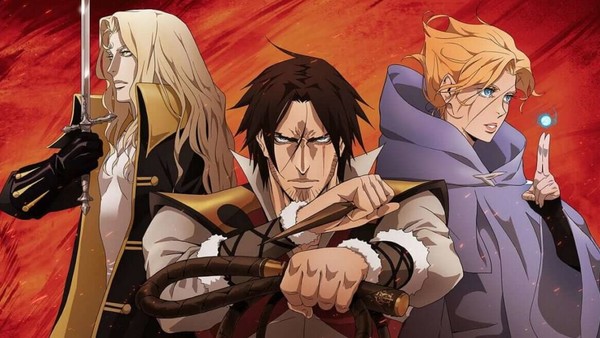How The Castlevania Netflix Series Managed To Get Video Game Adaptations Right
Beating Castlevania is hard, but adapting it into a TV show, that's a different story.

It's a story almost as old as the video game medium itself. A game comes out, and it makes enough money for Hollywood or the major TV networks to want to capitalize on it, producing an absolute abomination that disappoints players of the game, and fails to get new fans into the series.
Stuff like Street Fighter The Movie, The Super Mario Brothers Movie, or Mortal Kombat: Defenders of the Realm have all made fans second guess themselves when they wished for a movie to be made from their favorite game. That trend still exists to this day, but it failed to bring down Castlevania's animated series on Netflix, which has left just about everyone pleased, regardless of whether or not they've played the games.
Part of what helps Castlevania in particular is the inherent familiarity just about everyone already has with the source material. In many video game based movies or TV shows, pages of script and crucial screen time has to be used to bring viewers up to speed with what the hell a Goomba is or why on earth every thousand years we need to have a Mortal Kombat tournament.
The source material doesn't have to be explained for Castlevania's series, because anyone that's spent 20 minutes in a Halloween store knows about Castlevania's source material. Werewolves, Dracula, and demons are all something that is just embedded in the psyche of most of the English-speaking world. Nobody needs a novel's worth of explanation dialog on why stopping Dracula from taking over the world might be a good idea. Whether the audience has read the Bram Stoker book, watched the Universal horror films, or has simply rocked some fangs and a cape for trick-or-treating, they know what they're getting into.
The other thing that makes Castlevania a highly adaptation-friendly game is how rigid those original games were. While fighting games like Mortal Kombat have a litany of characters to play as, and more open-world games like Legend of Zelda support many different styles of play, odds are, if someone has beaten Castlevania III: Dracula's Curse, they've likely had a similar experience, gameplay-wise, to anyone else who's done it because the game is so linear. So many times in that game, it feels like the stimuli on the screen is controlling the player's actions, rather than giving the player the freedom to attack a situation any way they want to.
From there, all the Netflix series has to do is successfully import the Gothic anime aesthetic that had been with the series ever since Rondo Of Blood, as well as the series' iconic soundtrack that's consistently provided bangers ever since the old days of the NES.
This shouldn't be too hard, but bear in mind, Castlevania has been screwed up on TV before, like with Simon Belmont's ill-fated design that haunted episodes of Captain N: The Game Master.
By simply following the blueprint, Netflix effectively produced a layup with their adaptation of one of gaming's most historic franchises.
While Castlevania is one of the most adaptable series that gaming can have, one still has to be optimistic about future adaptations of other video games. Netflix showing that they can stick to the source material and not taint the franchise with both Castlevania and The Witcher, sets a much better precedent than Hollywood could ever manage in the 90s. Maybe now, gamers can fantasize about their favorite franchises hitting the silver screen without so much trepidation, inspired by the confidence that Castlevania gives them.